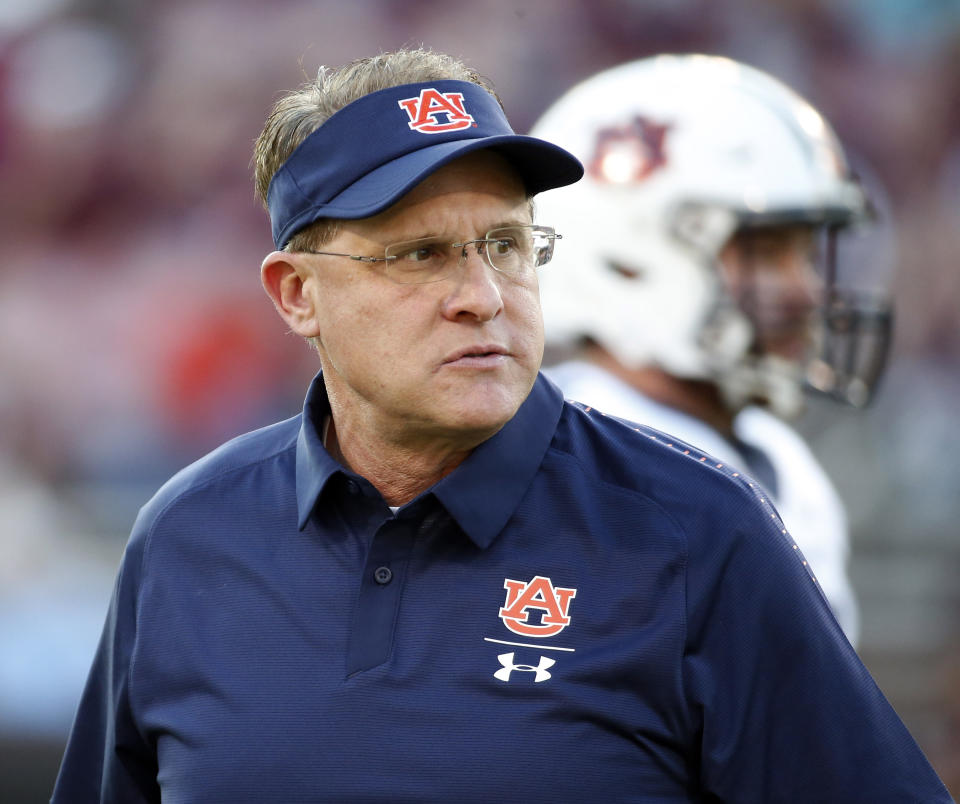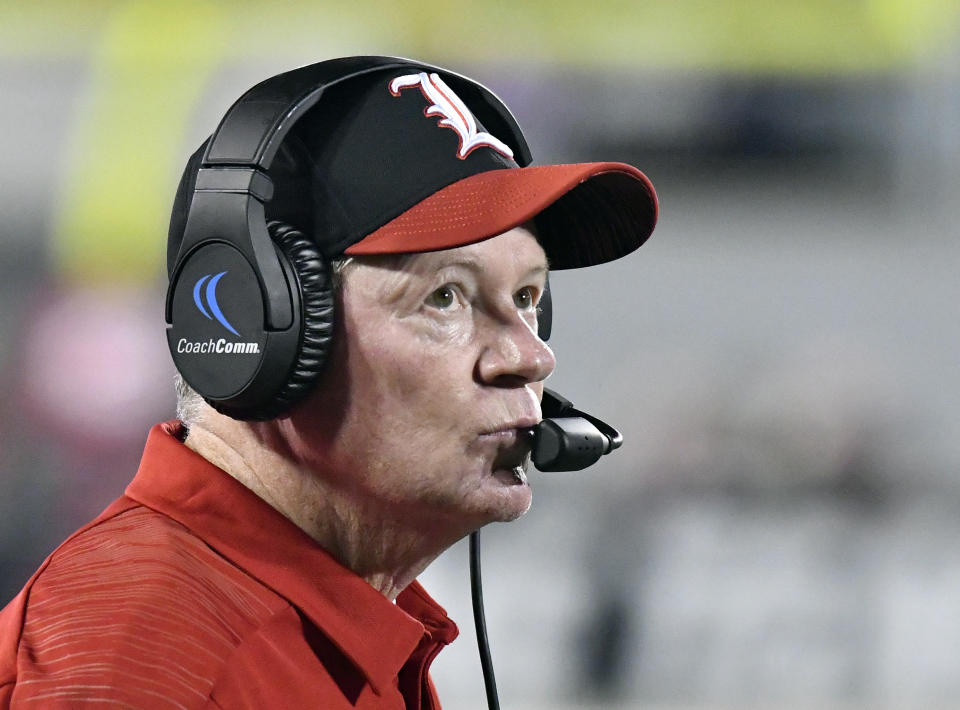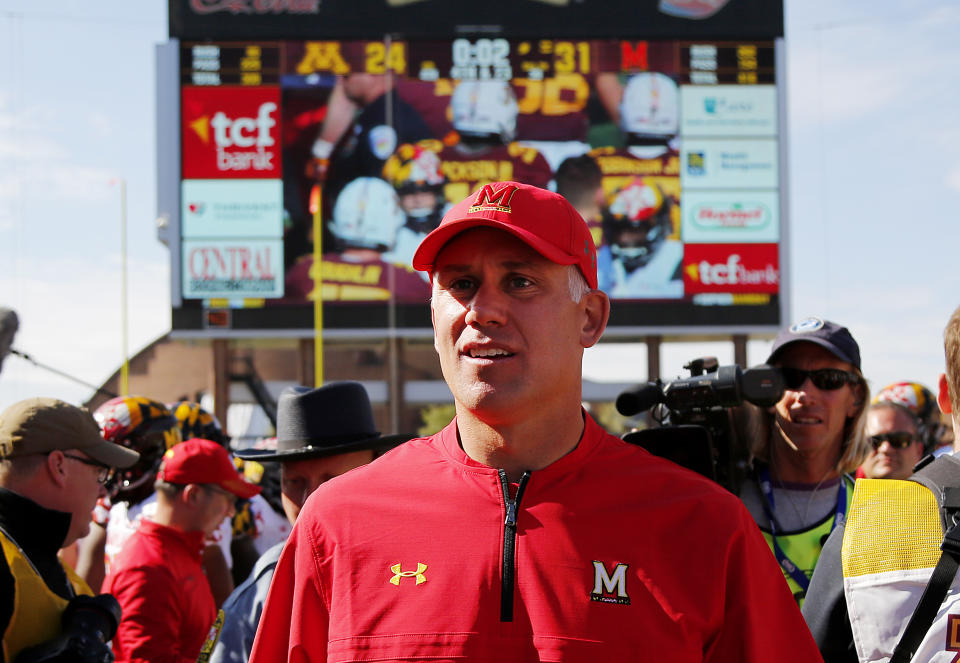College football's $100 million question: Can USC, Auburn and Louisville afford to fire their coaches?
The enduring lesson of the 2017 coaching carousel was that large contract buyouts can no longer be considered a sure-fire way to buy time. Yahoo Sports calculated at least $75 million from last year’s collegiate firing cycle potentially dedicated to paying coaches to no longer coach.
Eight-figure sums once deemed prohibitive – $11.9 million at Arkansas, $12 million at UCLA and $12 million at Arizona State – suddenly became the cost of doing business at programs where there’s only a modest history of success. While the prospect of mitigation and offset on some may diminish that $75 million in separation payments, the statement that buyouts are not obstacles was heard clear across the industry.
The prospect of another buyout bonanza looms again in the next few weeks, as the hottest seats in college football offer the potential of more than $100 million in buyouts. Some of the numbers are tricky to calculate because deals at private schools aren’t publicly available.
With $32.1 million potentially at stake at Auburn, an estimate of at least $15 million at USC, $14 million at Louisville and nearly $12 million at North Carolina, it’s fair to say there’s potentially even more money at stake in this carousel. (Those figures don’t include the cost of buying out staff, which is an increasing expenditure in an era of seven-figure coordinators and multi-year assistant coach contracts.)
“We saw last year schools like Arizona State, Arkansas, Texas A&M and UCLA pay $10 million buyouts,” said an industry source. “We’ll find out in the next few weeks if schools like Louisville and North Carolina are ready to pay bigger ones.”
With a few jobs potentially in flux in the ACC – Georgia Tech, Louisville and North Carolina – don’t discount the fact that there will be an influx of cash from the ACC Network to help pay off some of those buyouts. That’s an important revenue stream, as excess cash from the SEC and Big Ten networks have been significant drivers of coaching salaries. The ACC money is estimated to be $5 million extra per school for the first two years before going up significantly from there, depending on satellite distribution vagaries.
Here’s a look at the jobs potentially in flux and the money at stake. There are also predictions, which could drastically change as the results of the next few weeks will dictate the fates of some coaches.

Gus Malzahn, AUBURN
Buyout: $32.1 million
No place manufactures drama like Auburn, which appears to be having second thoughts about making Gus Malzahn the fifth highest-paid coach in college football. In Auburn’s defense, there was a market for Malzahn, and they just didn’t hand him a bushel of cash in a market where no one else would. (Arkansas was throwing around big numbers and the pull of home.) But after giving Malzahn a deal for $49 million over seven years, Auburn has woken up in 2018 with a throbbing hangover and riddled with regret.
Auburn is 2-3 in the SEC one year after winning the West, and it has returned to the role of being buried deep in Alabama’s shadow. And now the Tigers are faced with buying their way out of it with a deal that would make Kevin White’s ill-fated Charlie Weis contract at Notre Dame feel like pocket change. (Malzahn would be owed half of that $32.1 million within 30 days.)
Prediction: He’s safe, as Auburn shies away from becoming the laughing stock of college sports under new athletic director Allen Greene. Expect Malzahn to lead all the hot seats next season. Auburn will make staff changes, as offensive coordinator Chip Lindsey appears vulnerable. Perhaps Malzahn needs some introspection, as his offense looks stale.
Clay Helton, USC
Buyout: $15 million*
Clay Helton just signed an extension through 2023 and went 21-6 the past two years, winning the Pac-12 last year and the Rose Bowl in 2016. He shouldn’t be in danger, but the program has flatlined this season at 4-3, with bowl eligibility looking like a dogfight. Helton’s record before and after Sam Darnold became the starter is 11-9.
Athletic director Lynn Swann was bidding against himself for Helton, so this would be a particularly harmful decision for an administrator with little experience in, well, collegiate administration. (Swann didn’t hire Helton, and there are few outward signs the Trojans are aligned in any way other than contractual obligations.)
Helton has done exactly what USC hired him to do – run a clean program and end a decade of drama defined by NCAA sanctions, Lane Kiffin’s antics and Steve Sarkisian’s off-field issues. Helton has impeccable character and a sterling reputation, he just doesn’t appear to have the coaching acumen or personality of Pete Carroll. (Trying to live up to the standards of a program that achieved its heights while cheating is no fun.)
(*Helton has five years left on his deal, which isn’t available because the school is private. It’s safe to estimate that he makes at least $4 million a year and a good portion is guaranteed. So that leaves $15 million as a conservative estimate. It’s likely more.)
Prediction: Helton makes it with significant staff changes. He enters 2019 on the hot seat alongside Malzahn. Offensive coordinator Tee Martin and line coach Neil Callaway appear vulnerable. There’s a chance defensive coordinator Clancy Pendergast could be exposed as well.
Bobby Petrino, LOUISVILLE
Buyout: $14 million
Other than the exorbitant cost of the buyout, there appears to be little reason to bring Bobby Petrino back. The fanbase that welcomed his return now largely wants him gone, opposing coaches are wowed by the team’s lack of effort and the coaching staff is a case study in both defensive negligence and nepotism. (Three of Petrino’s relatives – his son and two in-laws – are on-field coaches making a total of $650,000.)
Louisville is 0-4 in the ACC, 2-5 overall, and could be staring at 2-10 and a winless conference season if it doesn’t beat Wake Forest on Saturday. The scene at that game in Louisville this weekend promises to be bleak.
Louisville is caught in the classic conundrum: “Can it afford to? Or can it afford not to?”
The athletic department is cash-strapped from scandal and buyouts, but when the hottest coach on the market – Purdue’s Jeff Brohm – is from your school and the city’s most famous football family, you pass the hat and figure it out. Petrino has won 70 percent of his games over his two stints at the school, but it’s hard to see him reviving this program back to that level.
Prediction: Right now, Louisville projects as the highest-profile opening. New athletic director Vince Tyra will figure out a way to find the money, which will be thorny as Petrino’s $14 million has no offset. The good news is that it would cost Louisville “only” $3 million to buy out Brohm from his deal after Dec. 5. Other names here would be Ohio State offensive coordinator Ryan Day and Troy coach Neal Brown.

Larry Fedora, NORTH CAROLINA
Buyout: $12 million
If Larry Fedora could have pulled North Carolina back to mediocre and kept himself out of the headlines, he’d probably sail back for another season. But he failed famously off the field, inserting himself at the forefront of the concussion debate with his infamous, “Our game is under attack” line at ACC media days. He added that, “Our country will go down, too,” making him mockery fodder for a few news cycles.
On the field, North Carolina remains a mess. The Tar Heels are 1-5 and staring at a third consecutive season of diminishing results. UNC went 11-3 in 2015, and has since gone 8-5 (2016), 3-9 (2017) and is 1-5 so far this season with a blowout loss to East Carolina. (They’d likely be 1-6 if a game with UCF wasn’t cancelled because of a hurricane.)
UNC won one ACC game last year and has one victory so far this season – both against Pittsburgh. UNC would tolerate decent football, but this is an extreme no one could see coming.
Prediction: North Carolina doesn’t want to fire him, but may have to. This will be a test of how much Carolina cares about football. Moving on is expensive, but can UNC afford to stay in the spotlight for all the wrong reasons?
Lovie Smith, ILLINOIS
Buyout: $12 million
The Lovie Smith hire is hitting the awkward crossroads where the gap between results and hope is nearly untenable. His buyout falls from more than $12 million this year to nearly $4 million next year, which may be enough to endure another season of losing 46-7 to Purdue. Illinois is 3-4, 1-3 in the conference and still generally hopeless. Athletic director Josh Whitman was quoted in the News Gazette in early October complimenting the direction of the program: “All signs right now I think are incredibly positive.”
Whitman hired Smith, so he’d have to own the administrative fallout of paying the massive buyout. Smith is 8-23 over three seasons, and the signs of hope have been sparse. (Illinois is No. 12 in the Rivals.com Big Ten recruiting rankings.)
Prediction: Whitman stands by his man for another year. There’s an apathy that’s overtaken the fanbase that makes the prospect of another season of losing appear reasonable. Illinois is a hard job, and with Smith’s dedication to playing an influx of young players there’s a case to give him one more year.
Chris Ash, RUTGERS
Buyout: $10 million
The administrative appetite to move on from Chris Ash is limited. Rutgers has been historically bad this season, which says a lot considering its dismal history. Much of that can be attributed to what little talent Kyle Flood left behind, as Rutgers is devoid of talent in its upper classes. Ash is 7-25 in Year 3, but it’s the way Rutgers has lost to schools like Buffalo (42-13) and Kansas (55-14) that has folks concerned.
It can’t be overstated that Rutgers’ athletic department is in a horrible financial situation, as the Scarlet Knights don’t get a full share of Big Ten money until 2020-21. This column from NJ.com illustrates how deep the financial hole is there, as there’s a calculated deficit of more than $47 million.
Prediction: Firing Ash would put the school back in the spin cycle, which makes the most likely scenario that there are staff changes with a focus on bringing in recruiters to upgrade the talent.
D.J. Durkin, MARYLAND
Buyout: $5.8 million
It’s nearly impossible to conjure a scenario where D.J. Durkin returns as Maryland’s coach. He has been on administrative leave since August after an ESPN story alleged a “toxic culture” in the program. It’s hard to imagine the school bringing him back, even if the internal investigation finds nothing. It’s also hard to imagine the Terrapins have found reason to fire him for cause, as they’d likely have begun the process of parting ways with him already.
Maryland is perhaps the hottest mess in all of college sports right now, as it’s reasonable to project it’ll have a new president, athletic director and football coach by next year. (There are not a lot of positive vibes around basketball coach Mark Turgeon, either, especially with some ties to the federal basketball scandal.) Maryland is also in financial trouble, which is the reason it went to the Big Ten in the first place. (Maryland, like Rutgers, doesn’t get a full Big Ten share until 2020-21.)
Prediction: Hard to project when you don’t know who will be in charge. Other than Durkin not returning, there’s an aura of mystery around the Terps right now. Expect a flurry of activity in the next month to set the table.

Paul Johnson, GEORGIA TECH
Buyout: $4 million
Tech is trending toward another losing season at 3-4, and there’s little juice in the program. Paul Johnson has had a great run there, as he’s 79-58 over 11 seasons. But with Georgia’s program building into a rocket ship and Tech failing to exploit a vulnerable ACC, Johnson’s run feels like it’s trending toward the end.
Athletic director Todd Stansbury has been back on campus since 2016, and there’s an increasing feeling that he’s anxious to get football more nationally relevant. Johnson is 61, which makes retirement a possibility. His buyout is also structured to be paid per season, which makes this reasonable for Georgia Tech.
Prediction: There’s a strong feeling in the industry that this opens, as Johnson’s program has gone stale. Look for the opposite of the option to come here, with someone like Washington State’s Mike Leach or Appalachian State’s Scott Satterfield perhaps emerging.
David Beaty, KANSAS
Buyout: $3 million
Firing David Beaty has been a foregone conclusion since athletic director Jeff Long was brought aboard in July. Kansas has been a graveyard for coaches since Mark Mangino left in 2009.
Beaty has won five games in four seasons and done little this season to show that he can lead Kansas back to Big 12 relevance. There will be plenty of Bret Bielema and Les Miles speculation here, or perhaps an outside-the-box name like Navy’s Ken Niumatalolo or Army’s Jeff Monken.
Prediction: This one is a matter of when, as Long may want a jumpstart to give his new coach a chance to scramble a signing class together. Long has plenty on his plate, as Kansas is navigating its role in the federal basketball case.
Bill Snyder, KANSAS STATE
Buyout: $3 million
Bill Snyder remains a wizard between the lines, as he has somehow kept a bowl game in sight despite a dismal start and little talent. No one will ever downplay his hall of fame credentials and uncanny ability to get his teams to play hard.
Snyder will turn 80 next season, and there remains a feeling that he’s going to hold onto the job until he can gift it to his son, Sean, which has long been his preference. That’s a no-go with current Kansas State administration, so Snyder continues to dig in and wait them out.
The tide is beginning to turn on Snyder in Manhattan, as his actions are perceived to be increasingly selfish. He risks tarnishing his legacy by leaving the program off in worse shape than he got it back from Ron Prince. But Snyder cares little about opinions or outside noise. High potential for drama here in the next few months.
Prediction: Athletic director Gene Taylor will have to have a difficult conversation with Snyder at the end of the season. Everyone around Kansas State wants a clean ending, but there are few signs it’s going that way. As we reported this summer, the likely candidates here would be folks with ties to Taylor, like North Dakota State coach Chris Klieman and Wyoming coach Craig Bohl.
[Subscribe to Yahoo Sports College Podcast: Apple• Stitcher • Google]
More from Yahoo Sports:
• Report: NFL admits it missed crucial helmet hit on QB
• Mike Oz: Dodgers need a whole lot more than Machado
• Broncos send backup QB packing after arrest
• Jeff Passan: How Game 1 personified self-aware baseball

